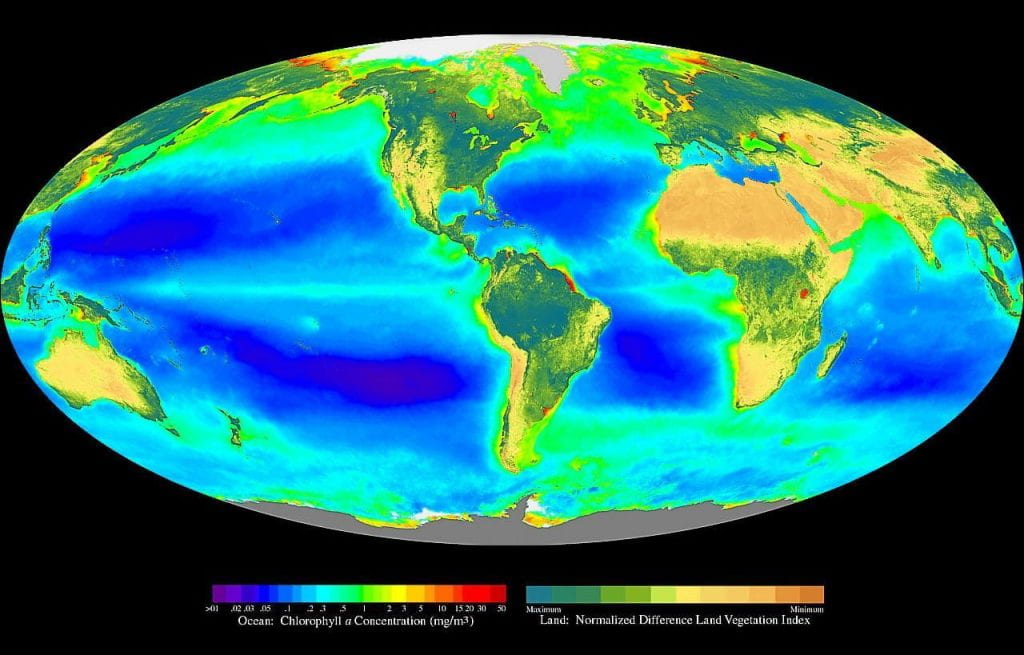Learning Objectives
- Identify the biotic components and abiotic components of an ecosystem, and describe how they interact
- Define primary producer, primary consumer, and secondary consumers and identify these in a food web
- Interpret a food web diagram with multiple trophic levels, and describe how these levels interact using top-down and bottom-up terminology
- Differentiate between net primary production (NPP) and gross primary production (GPP), and recognize that respiration by autotrophs (primary producers) is the difference between GPP and NPP
Biological communities interact with the climate, soil, atmosphere, and water to create an ecosystem. We consider ecosystems at the end of the ecology module because ecosystems bring together every element of ecology we’ve learned so far: physical environment, individual behaviour, population ecology, and community ecology.
Each population in an ecosystem can be labeled by how it fits into the trophic interactions, or feeding interactions, between species. Species that capture sunlight energy (or energy from inorganic molecules) and build it into chemical bonds through photosynthesis (or chemosynthesis) are called primary producers. Primary producers form organic matter from inorganic matter using the energy gained from outside sources. All other organisms are consumers that gain energy from the organic matter they consume. Primary consumers eat primary producers, while secondary consumers eat primary consumers, and so on up the scale of trophic levels. Detritivores are species that consume dead organic matter. Some species, such as humans, are omnivores because they can feed on producers and consumers at more than one trophic level. The top level in a chain or web of feeding interactions is often called the top carnivore. Production of consumer biomass is sometimes called secondary production (and likewise, consumers are also called secondary producers) to describe consumer biomass holistically.
Trophic feeding interactions can be mapped out into a food web that groups species by trophic level and connects “enemy” (herbivore or predator) to “victim” (producer or prey) with arrows that point in the direction of energy flow.
![A simplified community food web illustrating ecological interactions among species typical in a northern Boreal terrestrial ecosystem. Arrows indicate the direction of energy flow through the food web. (Source: Modified from Thompsma (Own work) [CC BY 3.0 (http://creativecommons.org/licenses/by/3.0)], via Wikimedia Commons)](https://bioprinciples.biosci.gatech.edu/files/2015/09/foodweb.png)
Within the food web, you can trace carbon and energy flow up each food chain by starting with any primary producer and following an arrows from it up to the next trophic level, and the next. For simplicity, producers are depicted at the bottom of the web, while the “top” consumers, usually carnivores, are shown at the top of the web diagram.
- Select a food chain and trace it through the food web above. What’s the maximum length food chain you can make?
- Imagine if the population size of the tree in the food web above decreased dramatically because of logging practices or an invasive pest that kills the trees. How would altering the bottom level of the food web affect population sizes up at the higher trophic levels of the food web? A change at a lower trophic level that impacts the trophic levels above it is called a bottom-up impact.
- How would removal of the coyote, the predator at the top of this food web, change population sizes and composition of species lower in the food web? A change at a top trophic level in the food chain that impacts population sizes at lower levels is called a top-down impact.
Primary Production Types
Globally, we quantify all the primary production, which is organic matter formed from inorganic matter by primary producers, to find the total, or gross primary production (GPP). Those primary producers metabolize (or use) some of the energy they acquire for their own growth and maintenance in a process called cellular respiration. The remainder is the net primary production (NPP), the amount of energy resources left for the consumers in the ecosystem to acquire through herbivory. Most of global NPP occurs in the world’s oceans, and particularly the greatest NPP per unit area is in algal beds and coral reefs. On land, while production is less compared to oceans, the community with the greatest NPP per unit area is the tropical rain forest.

The entire planet can be thought of as one huge ecosystem, called the biosphere, where energy flows into and out of the system openly, but matter cycles within the system.
Here’s Hank Green’s Crash Course video on ecosystems for review, and while you are watching, cast a critical eye on the food web diagram in the video and note what’s not right about it.
UN Sustainable Development Goal

SDG 16: Peace, Justice, and Strong Institutions – Ecosystems are connected, as are the people within them. The distribution of resources, and of pollutants, is often an environmental justice issue. SDG 16 aims to promote peaceful and inclusive societies, provide access to justice for all, and build effective, accountable, and inclusive institutions at all levels. By enhancing knowledge and awareness of ecological processes and the interdependence of living and non-living components, we can contribute to the development of sustainable practices and policies that ensure the well-being of ecosystems and support environmental justice.

